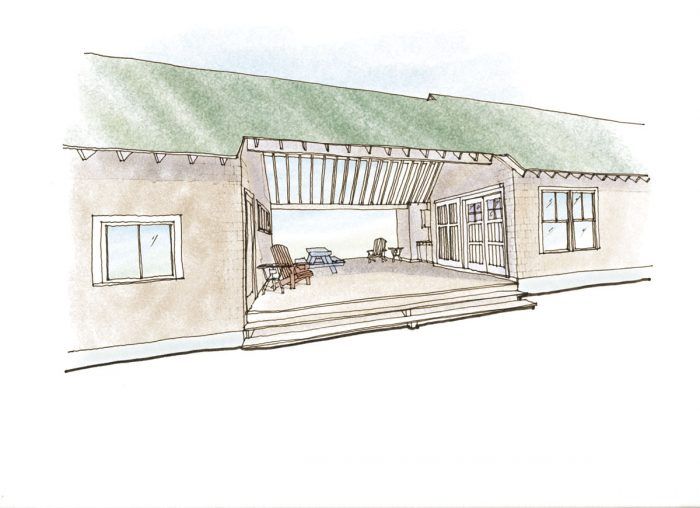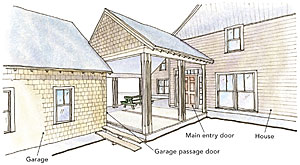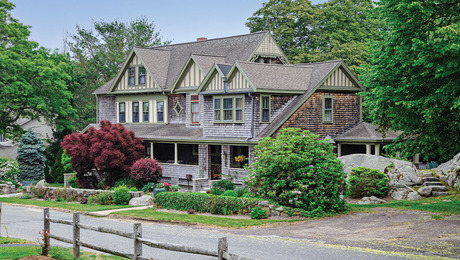Three Ways for Breezeways
Architect Katie Hutchison has observed that breezeways are making a comeback. She offers three carefully considered designs for homebuilders.

You may have noticed that the breezeway is making a comeback. A staple of connected buildings, the breezeway has long been a desirable device to join structures via a roofed, open-sided area. It allows both attached structures to access breezes and outdoor shade.
A breezeway on a summer home may connect shared living space on one end and more private bedroom suites on the other. Such a configuration allows for both privacy separation, air circulation, and an intervening shared porch-like space. A breezeway also can connect a garage and a house. With today’s focus on healthy indoor air quality, the breezeway is an effective device to keep the fumes and toxic products often found in a garage out of family living quarters while providing a welcoming shelter that can be used as an outdoor living space.
Here, we’ll explore three configurations for connecting a side-facing garage and a house. Each can allow for entry passage into the house and the garage, and each assumes a different relationship between house and garage. As with any design solution, deciding which is best for your project will depend on weighing the pros and cons as they relate to your goals.
Beyond these prototypical examples, you can find breezeways used in a variety of home designs. They include the 2018 Houses Readers’ Choice finalist Stillhouse Creek in North Carolina, a contemporary retirement home in the wine country of northern California, and a renovated historic home in coastal Maine.
Contained breezeway
This breezeway is contained by a gable roof that is common to both the garage and the house. This kind of composition lends itself to the clean-lined geometry of more contemporary and informal homes. (If both of these connected structures were living spaces, the breezeway could be called a dog trot.) Because this breezeway is flanked by structures of similar dimensions, it feels integral and room-like, and it can be interpreted as both outside and inside at once. It is a versatile space that easily accommodates picnic-table dining, guest entry, and entertaining, as well as circulation to and from the garage. It also strongly frames a view to the backyard that, depending on the view, can offer striking curb appeal.
Because this type of breezeway is contained on either side, it can suffer from lack of daylight. Opening the breezeway roof toward the rear, such that finished rafters are exposed, can brighten the breezeway. The exposed rafters can act as an arbor for climbing vines. Inserting translucent roofing toward the rear, in lieu of open rafters, is another option.
The end of the house that abuts a contained breezeway also can suffer from lack of daylight because windows and doors on that end are beneath the roof. Measures to brighten the breezeway via open rafters can indirectly improve interior access to daylight. Though many may see the contained breezeway’s strongly framed view as an asset, some may prefer a screened view of the backyard. Such a view can be created with lattice panels beneath the rear open rafters, though this also reduces access to daylight.
Funneled breezeway
When a garage and a house are angled toward each other, the breezeway in between can funnel access and views from a narrow entry plane to a wider rear expanse. This type of breezeway preserves some backyard privacy by presenting a tighter view to passersby. Because a funneled breezeway doesn’t share a common roof with the garage and the house, its roof can be inset from the front and rear faces of the house and the garage such that windows and doors in corners of both buildings have direct access to daylight. This breezeway also is narrower than a contained breezeway, so it doesn’t suffer as much from lack of daylight.
The funneled breezeway still only receives daylight from two sides, however, and its narrower design can make it feel more like a deck that pushes to the sides. The funneled breezeway shown below shares the garage eave line, which may associate it more with the garage than the house, further minimizing its room-like feel. To counteract that, the garage passage door is on the garage corner, so the garage end of the breezeway can be furnished with chairs and a small table. This means, however, that folks passing from the garage to the house initially are not sheltered. If shelter is your priority, then the garage passage door could be moved opposite the home entry door.
Offset breezeway
When a garage is offset from the house, the breezeway in between can overlap each such that both can be entered from the breezeway. Because an offset breezeway only partially abuts the garage and the house, it doesn’t suffer from lack of daylight; in fact, it receives daylight from four sides. It also can have a greater depth without risking loss of daylight to the breezeway, garage, and house. This offset breezeway shares the rear roof plane of the house and thus may seem more a part of the house than the garage.
Unlike the contained and funneled breezeways, which both best accommodate decks that push directly out from the front and rear of the breezeway, the offset breezeway easily accommodates a deck that pushes to the sides. This can be an asset when it’s desirable to have a deck directly off the rear of the house. The more-open edges of an offset breezeway can cause it to feel less room-like, though, and it runs the risk of feeling like a deep hall. To counteract an abundance of circulation space, locate a picnic table or other furnishings in the rear corner beyond the house.
The offset breezeway does little to screen the backyard from passersby, and it doesn’t frame the view as powerfully as the contained breezeway. It can, however, provide a more-direct view and more access to the main entry door than contained and funneled breezeways.
Drawings: Katie Hutchison
































View Comments
I would like to add a breezeway between my house and offset garage. I like the idea of the Offset Breezeway shown here, but my garage passage door is on the other wall, to the right of the garage window that is shown in the drawing. How would you recommend extending the breezeway to cover it as well (especially considering the roof)? Thanks!
With the onslaught of residential sprinkler systems, a covered deck combined with the garage and house can quickly take an exempt house and force it to have sprinklers installed. A costly surprise to finished homes. Always check with local building department & fire marshall, especially if your total under roof square footage is nearing 5000.
In our township, a breezeway connecting a garage to a house causes the house to be taxed as "attached garage" and raises your taxes. You may want to consider checking your tax department for zoning and tax consequences.